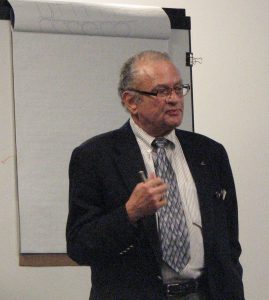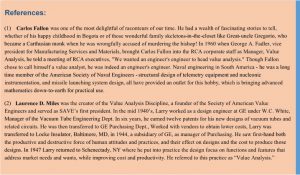From the collection of SAVE Fellow’s articles by Stephen Kirk, PhD, FAIA, CVS-Life, FSAVE, LEED AP – Dean, SAVE International College of Fellows
 By J. Jerry Kaufman, CVS-Life, FSAVE
By J. Jerry Kaufman, CVS-Life, FSAVE
It is commonly understood that the producer (or seller) sets the market value (or price) of the product or service offering, but the customer (or buyer) exerts significant influence on the value placed on those products and services offered. That influence can be expressed as worth.
The Difference between ‘Value’ and ‘Worth’
The terms ‘Worth’ and ‘Value’ are often interchanged in conversation, and when incorrectly used does not appear to take away from the meaning or the intent of the expression in which the terms are used. In other words, the buyer and seller understand their roles and act accordingly.
As an impressionable youth just entering the Value Engineering world, I was blessed to have as my mentor, Mr. Carlos Fallon. I learned that only someone who is an expert in his field has the ability and confidence to express him/her self in a way that makes complex subjects easy to understand. I take pleasure in sharing with you the event many, many years ago that led me to that conclusion.
As was the custom of SAVE International, Larry and Eleanor Miles hosted an annual SAVE Board meeting, and the social event that followed at the L.D. Miles estate on the Maryland shores. During one such event, I had the opportunity to ask Carlos Fallon, the international authority on value concepts and a SAVE Board member, to help me understand the perception of value. Rather than launching into a complex discussion of the various types of value (market, assets, wealth, etc.) Carlos asked me “How much money do you have in your wallet?” I opened my wallet and withdrew about $50.00.
Carlos said “Hold tightly onto that money because I will attempt to take it away from you.” He then said “I have an old pair of gym sneakers, a bit worn but filled with valued memories which I will, with reluctance, sell it to you for $50.00. Interested?”
I said “No way. Not interested in possessing your old worn-out pair of smelly sneakers, certainly not for $50.00.”
Carlos responded with “Okay, how about my 1.5 perfect carat diamond ring set in platinum. Would you buy it from me for $50.00?” I said “Absolutely!”
Carlos then asked me how I made my decision to reject the sneakers, but buy the diamond ring. I told Carlos “Because I thought the ring was worth $50.00, but the sneakers weren’t.”
“Ah” said Carlos “you have just made a valuable market decision by distinguishing between the terms Value and Worth.”
“Consider the term Value” said Carlos “as the posted market price, the price tag if you will. It is what I, as the seller, hope to get for selling my products or services. Worth is a buyer’s term; it is a personal determination that drives the buy motivation. Worth is also the factor that determines how I can separate you from your $50.00. If you think what I’m offering is worth it, that is you will benefit by it in some way, then we can have an exchange of values. The term ‘exchange of values’ implies that both the buyer and the seller benefit by the exchange, but for different reasons.”
Carlos’ motivation to sell his possessions is to gain financially by the exchange. My buy motivation is driven by one, or all three reasons for why anyone buys anything. Those reasons are:
- Exchange – Worth
- Esteem – Want
- Utility – Need
Therefore, buyers purchase things because they think they will benefit by the purchase. That is, they believe the item for sale is worth it, they want it or they need it, or a combination of the three.
All buy decisions contain worth. If we wish to re-sell our recently acquired product, worth would be the dominant buy factor. However, we can also be driven to acquire the offering by want, to hold in esteem like possessing rare stamps or painting by a known master. This market segment is known as ‘collectibles’ where esteem or want dominates the buy decision.
A simple example of need, or utility, is contemplating how much you would pay for some gas when you have run out of fuel in your car on a long stretch of infrequently traveled road in the late night hours. What would having enough fuel to reach civilization be worth to you at that time?
The Value Exchange Process
The exchange process always involves two distinct parties: the seller and the buyer. The intent of both buyer and seller is to profit from the exchange. The term ‘profit’ is defined as “…a gain from activity” which includes but goes beyond monetary considerations.
As discussed previously, we distinguished between the two terms Value and Worth by assigning Value to the seller and Worth to the buyer. We also established that it is the seller that sets the value of the products and services offered for sale. Also noted was that in commerce, Value is often represented by a price tag. The price established by the seller includes the seller’s profit expectations, as well as the cost of acquisition, risk, inventory, availability, buyer appeal, competition, market dynamics and other factors considered in preparing that offering for sale.
The decision to affect an exchange of values rests with the buyer, not the seller. The factors considered in the buy decision are too numerous to list, but once some personal worth index is reached based on the buyer’s perceived benefits, the sale is made and an exchange of values occur. Why refer to the process as ‘an exchange of values’ rather than ‘an exchange of worth’s?’ Because in completing the sales transaction, the buyer assumed the role of a potential seller and thereby establishing a new value for the item he/she recently acquired.
A procedure that attempts to better balance the value/worth scale is called “The Bargaining Process.” The bargaining process is an attempt by the seller to increase the buyer’s sense of worth by lowering its market value (price) or adding functions and features for which the buyer is willing to pay. Both approaches are in common use and have proved equally successful in the process of exchanging buyer/seller values.

